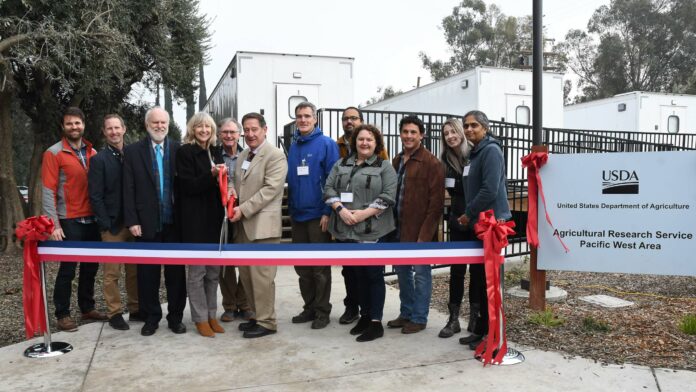USDA-ARS research lab provides opportunities for improving pollination health
The newly established bee research facility of the U.S. Department of Agriculture’s Agricultural Research Service (USDA-ARS) opened its doors to the public on Jan. 7 at a ribbon-cutting ceremony. Speakers commemorating this progressive step ranged from the USDA’s Pacific West Area Director to a former president of the California State Beekeepers’ Association.
USDA-ARS and UC Davis have had a long-standing and mutually beneficial relationship, according to Anita Oberbauer, the associate dean of agricultural sciences. She said that having this lab on campus will allow students to become more involved in research and outreach activities.
“The lab presence allows a partnership between researchers of UC Davis and the USDA-ARS to enable more rapid progress on some of the pressing issues facing bees,” Oberbauer said.
Among the speakers was Julia Fine, one of the two recently hired research entomologists working for the Invasive Species and Pollinator Health Research Unit with the USDA-ARS.
“The purpose of the lab, broadly, is to study honey bees and to evaluate different stressors to honey bees and ways to ameliorate the stressors in an effort to help increase the longevity of honey bee colonies,” Fine said. “So, we will be investigating stressors to honey bee health as well as trying to identify tools, techniques and management practices that beekeepers and growers can use to help their operations.”
Arathi Seshadri, the other newly appointed research entomologist in the unit, said although there are USDA-ARS facilities working globally to alleviate the problems of honey bees and other pollinators, the essentiality of pollination within California posed the need for a facility within the state.
“California […] is a place where pollination is extremely important,” Seshadri said. “We will be working with the local stakeholders, the beekeepers, the almond growers and all of these other communities to understand, ‘What is going on? What is the need? And how can we help meet these demands?’”
Fine said she hopes to find solutions that support both growers and beekeepers in their work, as the two occupations work closely together. With an emphasis on studying the lethal effects of environmental stressors on honey bee health, she sees the need to identify ways to mitigate pesticide stress. Fine’s initial interest in honey bees stemmed from their distinctive qualities and social structure. Studying the field of toxicology allowed her to combine her interests and passions into her work.
“Honey bees are incredibly potent as pollinators,” Fine said. “They pollinate so many of the different fruits, veggies and nuts that you consume and they’re very critical to ensuring that you have consistent access to nutritious food.”
Similar to Fine, Seshadri found her work in pollinator health to be a natural progression from her past experiences. After discovering topics related to plant pollination and reproduction while studying evolutionary biology, Seshadri began to work on insect behavior and honey bees as part of her postdoctoral degree.
“Plants and bees have evolved together,” Seshadri said. “There have been a lot of instances of how they have modified themselves to fit the needs of the plants, and plants in turn have adaptations that benefit the bees. So, bringing these two together, looking at how they work together and how we can improve that connection, is kind of a natural fit for me.”
Although Seshadri said she believes that there has been an increasing understanding of the importance of pollinators, specifically honey bees, she would like to emphasize the need for expanded awareness of the growing human influence on natural habitats.
“We are taking away a lot of the resources that the natural animal populations need, and, so, one of the big challenges that honey bees and other pollinators are facing is lack of natural habitat,” Seshadri said.
Due to the increasing scarcity of natural habitats, honey bees lack diet diversity and nesting resources. As a result, Seshadri advocates for people to plant flowers or other plants that actually offer pollen and nectar — such as wild flowers — as some horticultural varieties do not offer these essential resources. She also stresses the importance of minimizing the use of agrochemicals and pesticides for both local people gardening in their backyards and farmers trying to maintain their crop.
Although the study mainly focuses on honey bees, Seshadri said she believes that these honey bees can work as a model to improve the health of other pollinators as well.
“Given that humans [belong to a single species] on this planet and yet are doing the most damage for the Earth, there may be ways in which we can actually do something to sustain the Earth the way it is by thinking a little broader, not just what humans like and what is beautiful in our eyes,” Seshadri said. “If we go beyond and look at the ecosystem and the other organisms that are in the ecosystem, that will really help.”
Written by: Michelle Wong — science@theaggie.org




